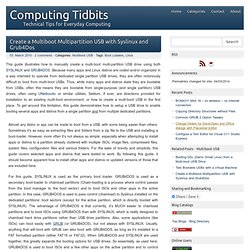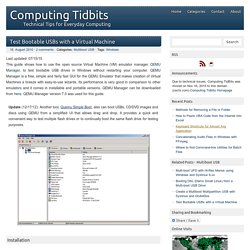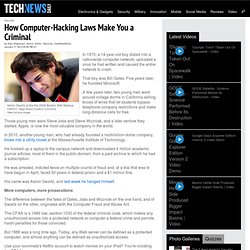

Create a Multi-boot Multi-partition USB. This guide illustrates how to manually create a multi-boot multi-partition USB drive using both SYSLINUX and GRUB4DOS.

Because many apps and Linux distros are coded and/or organized in a way intended to operate from dedicated single partition USB drives, they are often notoriously difficult to boot from multi-boot USBs. Thus, while many apps and distros state they are bootable from USBs, often this means they are bootable from single-purpose (and single partition) USB drives, often using UNetbootin or similar utilities. Seldom, if ever, are directions provided for installation to an existing multi-boot environment, or how to create a multi-boot USB in the first place.
To get around this limitation, this guide demonstrates how to setup a USB drive to enable booting several apps and distros from a single partition and from multiple dedicated partitions. Almost any distro or app can be made to boot from a USB, with some being easier than others. Operating Systems: Test Bootable UFDs with a Virtual Machine. This guide shows how to use the open source Virtual Machine (VM) emulator manager, QEMU Manager, to test bootable USB drives in Windows without restarting your computer.

QEMU Manager is a free, simple and fairly fast GUI for the QEMU Emulator that makes creation of Virtual Machines a breeze with easy-to-use wizards. Its performance is very good in comparison to other emulators and it comes in installable and portable versions. QEMU Manager can be downloaded from here. QEMU Manager version 7.0 was used for this guide. Update (12/17/12): Another tool, Quemu Simple Boot, also can boot USBs, CD/DVD images and discs using QEMU from a simplified UI that allows drag and drop. Installation For the installable version of QEMU Manager, enable KQEMU accelerator support for faster performance during the install process.
Creating a Virtual Machine After installation, click on the “+” (plus) button to create a new VM (Virtual Machine). For the advanced settings, use the default setting (Qemu Manager). S BootCD 15.2 - All in one Bootable CD. Antivirus Tools Avira AntiVir Personal Free anti-virus and anti-spyware on-demand scanner, detects and removes more than 50000 viruses and trojans.

ComboFix Designed to cleanup malware infections and restore settings modified by malware. GMER 1.0.15 Hidden services, hidden registry, hidden file scanner, Rootkit Detector and Remover. Remove Fake Antivirus 1.82 Tool to remove virus/malware which disguises itself to be an antivirus and produces fake alert/warnings and urge you to purchase a useless copy of the fake antivirus. SuperAntispyware Remove Adware, Malware, Parasites, Rootkits, Spyware, Trojan, and Worms (downloadable). TDSSKiller 2.8.13 Remove malware belonging to the family Rootkit.Win32.TDSS aka Tidserv, TDSServ and Alureon. Backup Tools CloneDisk 1.9.6 All in one tool for MBR, Partition, Disk, VMWare Disk images vmdk/vmx/vhd, and much more. DiskImage 1.6 Creates and writes disk images files to hard and floppy disks. BIOS / CMOS Tools Browsers / File Managers Cleaners CleanUp!
How To Copy a System Image from One Device to Another. Introduction This document explains how to copy a system image from one device to another within the same router, and from one router to another.

Prerequisites Requirements There are no specific requirements for this document. Components Used This document is not restricted to specific software and hardware versions. Conventions Refer to Cisco Technical Tips Conventions for more information on document conventions. Copying from Device to Device Inside the Same Router The table below provides command options for copying a system image from one device to another (methods vary according to different platforms): Command Summary The table below lists the various locations to which you can copy an image from a TFTP server. Router#copy tftp ? The three most common commands used for image copying are: copy tftp flash copy rcp flash copy slot0: slot1: Detailed Example router#show slot0:! The copy command shown below is used to copy the system image file from one device to another. Related Information.
How Computer-Hacking Laws Make You a Criminal. In 1970, a 14-year-old boy dialed into a nationwide computer network, uploaded a virus he had written and caused the entire network to crash.

That boy was Bill Gates. Five years later, he founded Microsoft. A few years later, two young men went around college dorms in California selling boxes of wires that let students bypass telephone-company restrictions and make long-distance calls for free.